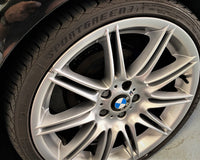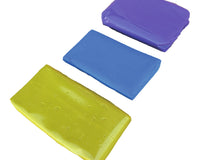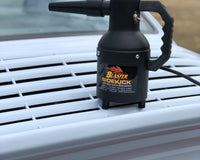ron filings and rail dust are some of the most stubborn and unsightly contaminants that can affect a vehicle’s paintwork. Unlike everyday dirt or dust, these particles are tiny fragments of iron and steel that become embedded into the surface of the paint. They are most common in areas near railways, industrial zones, and busy motorways, where metal particles from brakes, trains, or construction sites are released into the air and settle onto cars. Once lodged into the clear coat, they begin to oxidise and rust, leaving small brown or orange specks scattered across the panels. This not only spoils the look of the vehicle but can also lead to long-term damage if not dealt with properly.
The challenge with iron filings and rail dust is that they are often invisible at first glance, only becoming noticeable under certain light conditions or when the paint is washed. Drivers may assume the specks are dirt or tar, but standard washing techniques rarely remove them. Left untreated, these particles will corrode the paint, leading to pitting, etching, and compromised clear coat protection. For car enthusiasts and anyone looking to keep their vehicle in pristine condition, understanding how to efficiently remove iron and rail dust is essential.
Why Iron and Rail Dust Are So Damaging
The reason iron filings and rail dust are particularly harmful is due to their chemical reaction with the environment. Once these particles embed into the paint, they begin to oxidise, reacting with oxygen and moisture in the air. This process creates tiny rust spots that grow deeper over time, eventually penetrating through the clear coat and into the base paint layer. On lighter-coloured cars, especially white and silver, these spots stand out vividly, creating a peppered or freckled appearance.
Beyond aesthetics, the long-term risk is more concerning. As the rust develops, it weakens the surrounding paint, leaving it vulnerable to cracking and peeling. This compromises the protection of the metal underneath and may even lead to localised corrosion of the car’s body panels. Additionally, if rail dust is not removed before waxing or applying ceramic coatings, the contamination becomes sealed beneath protective layers, making future correction far more difficult. Addressing iron and rail dust early is therefore a matter of both appearance and preservation.
Spotting the Signs of Iron Filings and Rail Dust
Detecting iron contamination on your car’s paint requires a careful eye. Often, these particles appear as tiny orange or brown dots that resemble small rust specks. They are most common on horizontal panels such as the bonnet, roof, and boot lid, as well as near the lower parts of the vehicle where road debris accumulates. To check for contamination, wash and dry the car thoroughly, then inspect the surface under natural sunlight or with a detailing inspection light.
Another effective way to identify iron and rail dust is through touch. Running your hand gently across the paint after washing can reveal a rough or gritty texture, even if the surface looks clean. This is a strong indicator that contaminants are embedded within the clear coat. Professional detailers often use clay bars or iron fallout removers to confirm contamination, as these products react visibly when iron particles are present. Recognising these signs early makes removal much more efficient and prevents further damage.
Chemical Decontamination: Using Iron Fallout Removers
One of the most efficient ways to remove iron filings and rail dust is through chemical decontamination using dedicated fallout removers. These products are specifically formulated to dissolve iron particles safely without damaging the clear coat. When sprayed onto the affected area, the solution reacts chemically with the iron, breaking it down into a water-soluble form that can be rinsed away. Many fallout removers provide a visual indication of their work, turning purple or red as they react with iron contamination.

The key advantage of chemical fallout removers is that they can access and neutralise particles embedded deep within the paint, where physical cleaning methods cannot reach. This makes them an essential step in any decontamination process, whether you are preparing a car for polishing, waxing, or ceramic coating. For heavily contaminated vehicles, multiple applications may be necessary, particularly on panels near the wheels and lower bodywork. Ensuring the product is given enough dwell time to react properly is critical for effectiveness, though it should never be left to dry on the surface.
Mechanical Decontamination: Clay Bar Treatment
While chemical fallout removers are highly effective, they work best when combined with mechanical decontamination. A clay bar or clay mitt is designed to physically lift bonded contaminants from the paint surface, including iron filings, tar, and industrial fallout. Once lubricated with a detailing spray or clay lubricant, the clay is worked gently across the panels, grabbing onto embedded particles and pulling them free from the clear coat. The result is a surface that feels smooth to the touch and ready for polishing or protective treatments.
Clay barring is particularly useful for removing stubborn particles that chemical fallout removers may not fully dissolve. However, it requires a delicate technique, as pressing too hard or using a dirty piece of clay can induce micro-scratches in the paint. This is why it is usually followed by polishing to refine the surface. For older vehicles with years of contamination, combining a fallout remover with clay treatment is the most thorough method of achieving a contaminant-free finish.
Combining Both Methods for Maximum Effectiveness
The most efficient way to remove iron filings and rail dust from paint is to use both chemical and mechanical decontamination together. Starting with a fallout remover breaks down the majority of iron contamination, reducing the risk of dragging particles across the paint during clay barring. Following up with a clay bar then removes any residual contaminants, leaving the surface completely smooth and clean. This two-step approach is considered the gold standard in detailing and is recommended before applying any kind of wax, sealant, or ceramic coating.
This combination not only restores the clarity and smoothness of the paint but also ensures that future protective layers bond properly. Without thorough decontamination, coatings may adhere unevenly or fail prematurely due to trapped contamination. For enthusiasts who want their detailing work to last, taking the time to carry out both chemical and mechanical decontamination is essential.
Preventing Future Iron and Rail Dust Contamination
Protective Coatings
Once the car has been fully decontaminated, applying a protective coating is the best way to guard against future iron and rail dust contamination. Waxes, sealants, and ceramic coatings all create a barrier that reduces the ability of iron particles to bond to the paint. Ceramic coatings in particular offer strong chemical resistance, making future decontamination easier and less frequent.
Washing Techniques
Regular washing using pH-neutral shampoos and microfibre mitts also prevents contamination from building up. Paying extra attention to the lower body panels and wheel arches is important, as these areas are most exposed to rail dust and brake fallout. Drying the vehicle properly with a soft microfibre towel or blower also helps minimise the risk of water spots combining with iron particles to create corrosion.
Routine Decontamination
Even with protective coatings, periodic decontamination should be part of a detailing routine. Using an iron fallout remover every few months ensures that any particles that do bond to the paint are neutralised before they can cause lasting damage. For vehicles driven frequently near railways, industrial areas, or in city traffic, more regular decontamination may be necessary to maintain a flawless finish.
Conclusion: Keeping Paintwork Free from Iron and Rail Dust
Iron filings and rail dust are a silent but damaging threat to any vehicle’s paintwork, particularly in areas where industrial fallout is unavoidable. Left untreated, these contaminants corrode the clear coat, spoil the appearance, and compromise the long-term protection of the paint. The most efficient way to tackle them is through a combination of chemical fallout removers and mechanical clay bar treatments, ensuring a thorough decontamination process.
By adopting protective coatings, proper washing methods, and routine decontamination, car owners can keep iron and rail dust at bay, preserving both the appearance and value of their vehicles. For anyone passionate about car care, learning how to remove and prevent these contaminants is a vital skill that ensures a professional finish every time. With consistent care, your car’s paintwork can remain smooth, glossy, and free from the damaging effects of iron and rail dust.




